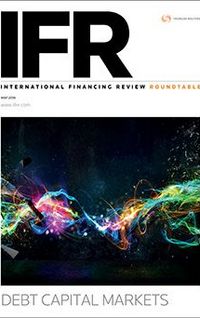Keith Mullin, KM Capital Markets: Welcome to the 2018 Thomson Reuters IFR Debt Capital Markets roundtable. Bond markets have been buffeted by a number of themes so far in 2018. Fed tightening and US curve-flattening, ECB taper-talk, equity market volatility, credit spread widening, high Libor-OIS spreads, and broader concerns around jobs, growth and inflation are just some of the elements playing into the market right now.
How should we interpret all of this in terms of how it impacts deal-making in the primary market, from the perspective of the size of deals that can be done, pricing, deal execution and managing the aftermarket?
Mark Lewellen, Barclays: Thinking about the US specifically, Fed monetary policy has been very well flagged. There are mixed views in terms of how many hikes we will see this year but that’s also been well signalled and I think the Fed has done a pretty good job.
We recently did a survey of institutional investors. Views on the number of rate hikes are relatively well balanced. What’s interesting, though, has been the impact on the yield curve, particularly 10-year Treasuries. They seem to be anchored around the 2.8%-2.9% area and there’s been a lot of discussion about whether we would sustainably break through 3%.
But in spite of all of that, US credit markets have remained remarkably robust. Supply is down quite considerably but I think that’s more due to issuer reasons, particularly around things like tax reform, capital repatriation and the discussion around the tax deductibility of interest, which are having an impact on the need by US corporates to fund. But institutional investor demand for credit remains very good.
You mentioned, Keith, the size of transaction that can be done. CVS was in the market in March with a US$40bn trade that went very well with an order book that was multiple times oversubscribed. General sentiment towards investment-grade credit remains very strong.
The picture is a little different for high-yield, which is a bit more susceptible to absolute interest rates and there are retail ETF holdings in high-yield so you tend to see more volatility in terms of inflows and outflows. But generally speaking the US market is undoubtedly more stable and new-issue premiums have remained relatively stable compared to Europe.
Keith Mullin, KM Capital Markets: But we have seen some credit spread volatility in the US.
Henrik Johnsson, Deutsche Bank: 2018 is not 2017. Throughout this year, we’re going to see much more volatility in every asset class. Considering volatility was at an all-time low last year, maybe that’s an obvious statement. What we’ve seen in the primary and secondary markets in the first quarter on both sides of the Atlantic has been very instructive of what’s going to happen.
Issuance is way down, as Mark mentioned, but that is based on issuer reasons rather than investor demand and it’s been keeping markets relatively stable. Even though we’ve experienced some equity volatility, the combination of low primary debt issuance and central bank buying – particularly in Europe, but also in Asia – has kept credit spreads surprisingly robust.
We were very surprised in January that the market was as good as it was because we thought the disruption we were expecting in 2018 would happen sooner than it has. The reason you’re all of a sudden seeing more widening in credit spreads is because supply has caught up.
In the couple of weeks leading up to Easter, you suddenly started seeing more deals, even a few weekly supply records being set so investors’ reduced cash balances became more of a factor, together with the fact that there isn’t much dealer inventory to support the secondary market.
As we go forward into 2018, what you’re going to see is days when everything seems fine and issuance flies out the door, and days when navigating the markets will be more challenging. It’s not necessarily US macro; it’s going to be issuance trends, it’s going to be political stuff.
Keith Mullin, KM Capital Markets: There are questions, Jean-Marc, about the extent to which higher Treasury yields will have a pull effect on investment-grade credit, and about the impact of higher front-end Treasury yields. If we look back over the cycle, we’ve seen a significant migration of rates buyers into the credit space as a consequence of the NIRP/ZIRP environment. Is that likely to reverse as the Fed carries on raising rates and is a 3%-plus 10-year Treasury the trigger? Could credit suffer a bumpy ride as the markets reappraise the risk-return relationship?
Jean-Marc Mercier, HSBC: No question. At HSBC, we disagree with the view that the 10-year is going to 3.5% or anything like that. Actually, we think it’s going back to 2.3% so we’re probably a big outlier there. In that sense, we are bullish but I do think there is a link; a degree of sticker-shock.
Some of our issuing clients are unwilling to do transactions right now because they see where we were in terms of credit spreads, in terms of absolute yield, and it’s painful to see where they are now when even three to six months ago conditions were much better. We’ve gone up a point on 10-year Treasuries since that period pre-ECB corporate sector purchase programme in early 2016.
So, yes, it is a drag. International bond issuance is down 9% but it’s worth remembering that last year was a record year. If you compare it to two years ago, three years ago, five years ago, it is still the second-best year for several years. I’m not too worried; a lot of clients are looking at funding.
We might be surprised to find that we end up with a small reduction compared to a record year last year. The US has a lot of uncertainties, which makes it difficult for people to plan, but Europe is in good shape.
However, in terms of getting deals done, things have totally changed. Whereas before you could put anything on a screen and it would get done, we’re back to trench warfare where one day is good, one day is bad. You really need to have your ear to the ground and know what’s going on around investor flow.
You mentioned investors shifting their money. We have seen some of that in 2018 and things can be quite volatile. The situation has radically changed. We’ve seen Fed money, BoJ money, Bank of England and ECB money coming into the market that totally changed the picture, price-wise and liquidity-wise. That is clearly changing. I’m confident we can navigate but we will have to navigate.
Keith Mullin, KM Capital Markets: On the subject of central bank liquidity, the ECB’s intentions around its asset purchases have caused some consternation. The issue of policy rates is less the concern today but on the basis that bond markets are global and flows are global, how do you read the interplay between what the Fed is already doing and what the ECB is just turning the corner to start to do?
Jean-Marc Mercier, HSBC: That’s exactly the point. When everybody is playing the same game, it’s amazing. But as soon as you have different dynamics, you get some good days, some bad days. It’s like south of Cape Town where two oceans meet; you get some days driven by bad news on the Fed; others driven by good news on QE in Europe or the other way around. It can cause boats to rock.
Frederic Zorzi, BNP Paribas: Let’s be clear: neither 2017 nor 2016 were normal in terms of volatility in any market. Investors understand that. We are back to what the markets should be. That’s the first thing. Second, we should not forget that if we look at the US in terms of secondary market liquidity in credit and compare it to pre-crisis, we are at one-fifth of where we were at the time in a market that keeps on growing. So, we have this inverse scenario.
Even if we look post-crisis, at 2008-2009, we are a quarter of that today. There’s a deep interconnection between markets; that’s a fact. The markets are also becoming highly technical. That’s something we also have to bear in mind.
If we look at QE, to go back to your question, the situation in Europe is very different to the situation in the US. QE in the US was very specific and the withdrawal was very well flagged. It’s been the same in Europe except Europe is in a different cycle.
Even though the most recent numbers were not as strong as expected, the European economy hasn’t seen this kind of growth. If we look at past cycles, growth in Europe has been historically driven by the growth in the US. This is the first time we’re seeing growth in Europe driven on its own.
You can say ECB [tapering] has been well flagged. But by the same token, we have never experienced QE of such magnitude. If we focus on the credit side, you can say it’s been well flagged but we haven’t seen the effect yet. Why? Because the whole asset purchase programme may be down by 50% compared to the start of the year but if you look at the corporate purchase programme, which clearly has the biggest impact on credit, it’s only down by 15%-16%. In the past few weeks, ECB corporate purchases have been a lot lower with lower activity in secondary and suddenly you’ve seen corporates outperforming financials.
It’s very difficult to predict. Yes, it’s well flagged but we will need to see where we are in Q3, Q4 in terms of overall activity. The impact will be highly dependent on the state of the market. In theory, there’s a high correlation between the PMI in Europe and iTraxx credit spreads. But if there’s a slowdown of growth in Europe combined with QE, the impact can be greater.
By the same token, even if Europe remains strong and spreads go wider in the US, even if the two economies grow at the different pace or we get different trends in the cycle, there will be an impact in Europe. That’s a fact.
Keith Mullin, KM Capital Markets: Henrik, bearing all that in mind, where you have up days and down days but you can’t predict which it will be, how does that change the way that deals are put into the market so you hit the right price?
Henrik Johnsson, Deutsche Bank: It’s hard to answer your question broadly because there are so many different types of issuers but Fred made exactly the right point. This is really just going back to the way the market used to be. 2017 was an exception. You could put anything on screens and it sold.
In terms of high-yield, subordinated financials, smaller tranches, emerging markets, the marketing aspect is definitely becoming more important. You see more roadshows, you see wall-crossings, we sometimes try to do bilateral deals with a few investors; private placements, things like that.
As the market gets choppier, you don’t risk putting something tricky on the screens and hope for the best. Even when you go up the credit spectrum and move to more standardised things like covered bonds, there has been some surprise at the kind of new-issue premium on deals.
At the end of last year and into January, a covered bond would have half a basis point to one basis point of new-issue premium. Now you’re sometimes seeing five-plus. You do try to get that back during the execution process but the feedback we’re getting very consistently from investors is: “We’re no longer desperate to put money to work. Now you need to pay us properly”.
The primary market, fortunately for us in DCM, is where they want to put their money. But they want to make sure that they’re insulated from some of the poor secondary market performance that we’ve seen in March.
Keith Mullin, KM Capital Markets: Indeed, just on covered bonds, if you look at the pricing dynamics particularly of Pfandbrief issuers in Germany, they were coming into the market with very tight sub-swap spreads but they experienced investor push back and a lot of issues struggled to get over the line.
Henrik Johnsson, Deutsche Bank: This is something that all of us have seen time and time again – and we’ve been doing it a long time. When you get market widening, it takes time for issuers to adjust. They’ll say, “the price that you showed me last week, that’s the one I want to hit”. Then we have to have a conversation about it. Sometimes you convince them to go wider, sometimes you don’t and it goes out slightly too tight. But the market, eventually, just by putting deals out there, learns the hard way that you need to start wider. That’s the kind of phase we’re in right now.
Mark Lewellen, Barclays: It normally takes one challenging transaction to persuade the issuers coming after that that they need to widen the concessions. One interesting overlay, though, is CSPP, which has undoubtedly created a distortion on valuation.
There’s clearly been a lot of talk around withdrawal, around how quickly that’s going to happen. It’s clearly going to happen over a very long-term scale. It’s clearly going to be very staggered. The analogy I use is it’s almost like having stabilisers when you’re teaching your child how to ride a bike.
When you’re confident that it’s going in a straight line, there’s some good momentum, you take those stabilisers off and everything goes well. But when it hits a pothole then, boom, there are no stabilisers and the child comes off. What investors are concerned about is that they’re buying at spreads they feel have been artificially distorted by a very price-insensitive buyer that has bought a meaningful proportion of transactions.
They have the confidence that withdrawal is going to take a lot of time but there’s a lot of concern that when you get volatility that may happen for a completely different reason, you’re not going to get that comfort and that insulation we’ve had through the ECB buying. That is causing some of the nervousness we’re seeing in primary markets at the moment in Europe.
Keith Mullin, KM Capital Markets: Emerging markets have been quite resilient and we’ve seen a lot of EM issuance in dollars. When we’ve had previous instances of Fed rate tightening, it has led to EM volatility, particularly around countries that depend on external capital flows to finance current account deficits. They’re very sensitive to dollar interest rates and FX. Why has EM had such a soft ride?
Jean-Marc Mercier, HSBC: It’s a very good question. The first thing is emerging markets do depend on the level of Treasuries or overall Fed yields but actually a lot rides on forex. And the dollar has been relatively soft, which is why EM is still doing extremely well.
The other thing is that while the market was good, a lot of our issuer clients went longer. And they have very strong balance sheets. In fact, there are lot of strong reasons: a lot of EM countries have better financials, excess capital, and better governance than was the case 10, 15, 20 years ago.
The other thing is in Asia, for example, we really do see Asia buying Asia. The pool of money supporting their own names is extraordinary compared to six, seven years ago where you needed the 144A format to do anything. You had to go to the US to get money; today, you use a Reg S and you’re done for US$1bn-plus.
Henrik Johnsson, Deutsche Bank: Plus, it doesn’t hurt that you’ve got coordinated global growth, which tends to lift EM confidence.
Mark Lewellen, Barclays: And a lot of the countries are commodity-based and oil has stabilised. Two years ago, it felt very different.
Frederic Zorzi, BNP Paribas: And flows are important if we go back to technicals. If you look at high-yield and EM over the past three months, the flows have been completely inverse. It’s not a question of high-yield flows switching to EM but you do keep on seeing money coming into EM.
As Jean-Marc said, it’s a dollar-driven market. I think there is broad agreement that the dollar is likely to continue to be weak; this continues to support EM. The outlook is positive. This is a market that is growing; in dollars last year we had close to US$600bn of EM supply. And Jean-Marc is right, there’s a lot more local money.
We have also seen a lot more diversification in terms of issuers coming to the market. If we look at last year, even the beginning of this year, a lot of the transactions we did were for debut issuers. It used to be a market where it was always the same names coming over and over again. There’s a lot more diversification now.
Keith Mullin, KM Capital Markets: I want to move on to discuss financials supply in the bond market. I think there’s relative clarity around banks’ capital financing needs for TLAC/MREL and other forms of debt including senior preferred and non-preferred. How do you see the emergence of bank issuance over the course of this year?
Henrik Johnsson, Deutsche Bank: According to our stats, financials did half of all issuance in Q1 2018 compared with 30% in Q4 2017. While corporates have been way down, financials have been flat. Speaking to bank treasurers, there’s just been a desire to get funding out of the way.
There are probably nuances in terms of the capital structure but the generic desire is to go and print capital and get funding while the market is stable. That was driving the heavy issuance in Q1 and that’s probably going to continue, although it’s harder to be opportunistic when markets are volatile.
Mark Lewellen, Barclays: Financials have been one of the significant issuance areas compared to corporates. TLAC and MREL requirements are significant and a number of clients have got to grips with their stack. Legacy AT1s are coming up for refinancing and that’s creating some opportunities; we’re seeing second and third-tier banks in different jurisdictions getting to grips with their legislation and you’re seeing debut senior non-preferred. There’s a lot of issuance waves.
When you put the volumes together, the needs are significant. Yes, you can worry about your new-issue premiums, and you can worry about a bit of volatility. But realistically, borrowing costs are still attractive and markets are open.
A lot of financial institution borrowers can’t really afford to sit and wait for markets to be better and for new-issue premiums to contract because of those significant requirements. If we’re talking about what will drive supply this year, for me, this year, financial institutions are where I see the biggest growth.
If we are going to get anywhere near the total volumes we saw last year, it’s going to have to come from financial institutions. One area I think is going to be interesting for European banks is the Yankee market because, talking about the drop-off in domestic US supply, there is going to be latent demand from US institutional investors for credit.
They’re not going to get it from their home names because of tax reforms so Yankee supply can fill that buffer. That will keep spreads and that relative arbitrage in the US versus Europe looking pretty attractive.
Jean-Marc Mercier, HSBC: If you look at financial issuance, we’re down 3% so far this year, so basically flat. But the picture is very diverse: covered bonds are up 23%, capital issuance is up 4% globally while senior is down 10%.
Banks are very savvy; they do this stuff every day. They usually have the same people running the book of the bank and the funding so they really have their fingers on the pulse of the market. Today it’s a question of getting back to being savvy about your execution strategy and doing the investor work so you are ready to go.
We are seeing the two extremes: the high-beta stuff getting done on the right day but a tough market for the bread-and-butter stuff so let’s do covered and wait and see what happens. And you have to be very flexible about whether you do US dollars, Singapore dollars, Hong Kong dollars, euros or sterling.
Keith Mullin, KM Capital Markets: Despite all of the moving parts and the volatility, we haven’t had any notable failures out there…
Frederic Zorzi, BNP Paribas: Not yet. But you’re right, deals are getting done even if issuers sometimes find it hard to adjust. For me, the key challenge today, going back to your previous question, is what difficulties are we going to encounter around pricing?
People might say that all syndicates are lazy and just add 20bp-30bp and get the deal done but the key question for the market and a key evolution is figuring out the price/size equation. We’ve already mentioned CVS; it’s same in high-yield: a lot of the growth in the market has been M&A-driven.
There was a time when refinancing US$5bn in the bond market was a big deal. Now it’s US$40bn. Of course that’s been helped by the rise of assets under management. But this is where, at some stage, the market is going to hit a wall. There
will be a transaction, whether it’s in high-yield or an LBO, where it will be a challenge to raise the size.
It won’t signal the end of the market but it will be a cause for the market to pause and the banks will have to step in and do what they do: extend balance sheet. The difficulty today is what size can the market do?
There is no right and wrong. It’s not like doing US$40bn is impossible; CVS shows that’s not the case. But where we are moving – and we didn’t really talk about this in 2017 – is the return of idiosyncratic risk. This is the year where we see single-name issues, whether it’s Carillion in the UK (which didn’t have a big impact on the bond market) or Steinhoff and others in high-yield.
The trend we’re seeing is that there is going to be a difference between names. There will be names that will get done really well and can do big size at a decent price, and some that will not have access to this pool of liquidity. The challenge for banks and capital markets professionals is being savvy enough to have this understanding of credit, and this understanding of credit versus investor appetite.
Which names are going to work, let’s say, for a US$5bn deal? Which name will only work for US$1bn? How we advise our clients on the issuer side is what will make the difference between the banks. That’s our challenge for the next few years.
Jean-Marc Mercier, HSBC: It’s been 20 years since the euro was introduced. The largest M&A bond refinancings in the US have been above US$40bn; the largest almost reached US$50bn. One of the largest deals for a European name refinancing in euros was Sanofi’s €8bn six-tranche bond [to refinance its takeover of Bioverativ and Ablynx]. It’s really encouraging to see European companies able to fund in their own currency.
Henrik Johnsson, Deutsche Bank: On a more generic point, there are strategists and hedge funds saying, “short the market, it’s going to be a disaster”. I don’t see that from my vantage point. Trying to short the market here is going to be very difficult because things are quite different from the crisis situation we saw at the time of the global financial crisis.
The ECB is not suddenly going to withdraw liquidity and cause carnage. The economy is growing and corporate profits aren’t at all bad. You should see more cash flow into the European real economy. The overarching theme for issuers and investors is to try to avoid the idiosyncratic pitfalls that Fred referred to. Being long credit is still an OK trade. That’s what we’re seeing in reality when we talk to investors.
To see the digital version of this roundtable, please click here
To purchase printed copies or a PDF of this report, please email gloria.balbastro@tr.com






